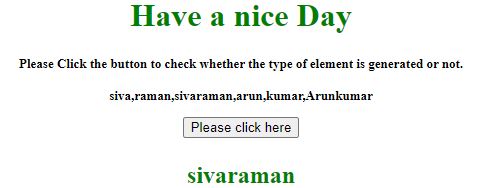Updated July 4, 2023

Introduction to JavaScript Random String
In JavaScript, we have used a string concept with a different set of scenarios, and also, mainly, we have declared the variable values with the string formats. In string, the format has different types of conditions to check more than one variable in the javascript code. Reverse string, random string, etc, are some techniques that will use the string datatype values to compare and satisfy the user conditions. These techniques will have default methods in javascript collection of characters to combined called strings so if we want to use the random string, we must calculate the characters in the script.
Syntax
All programming languages have default rules and syntax for writing the codes in the projects. So likewise javascript has its own syntax for writing the script on the web page. To calculate the random string in the script, we must follow the syntax below for generating the random string characters in the script.
<html>
<head>
<script>
function name()
{
var variable name; ///declaration using string datatype values
using some loop to iterate the string
using Math.random() default function to generate random strings.
---some javascript logics—
}
</script>
</head>
<body>
</body>
</html>Explanation: For the above codes, we have used javascript functions with some logic, and we used an in-built method called Math.random() function is used to generate the random strings on the web page.
How does javascript Random String work?
When we want to generate random strings in the script, we must follow the ASCII codes and default method called Math.random() method we all know about the ASCII code starting from a to z(while using small alphabets) if we want to use numbers its start from 97 to 122 so the random strings will be calculated from the numbers 97 to 122 is the default range so in particular ranges the random number is generated using Math.random method.
If we want to generate random string characters with capital letters alphabetical characters, it will start from the ranges between 65 to 90. We can also generate the application using the encryption key want to create random strings with a minimum chance of either duplication of the strings or collision of the strings.
We used Math.floor() method also to generate random alphanumeric strings in javascript. It does not have a default random strings generator method. We will create a custom-side script function for generating both random and unique formats of the strings in the script. If we want to identify and easily detect the solution, we may use the above two methods Math.random() and Math.floor().
When we use Math.random() function, it will return the floating-point type of values also Pseudo-random numbers range between 0<1 to be approximate ranges with a uniform distribution over the ranges between scale and desired ranges in the algorithm point of view the above points are used to step by step procedure for random numbers or strings, but in implementation point of view it will be the initial seed to the random number generation algorithm will be followed it cannot be chosen or reset by the web users.
The values will be Uppercase, Lowercase, or any other symbols with key strings; these are things that need to generate the random strings in javascript.
Examples to Implement JavaScript Random String
Below are some examples mentioned:
Example #1
Code:
<html>
<head>
<title>Welcome To My Domain</title>
<script type="text/javascript">
function demo() {
var c = "ABCDEFGHIJKLMNOPQRSTUVWXTZ0123456789abcdefghiklmnopqrstuvwxyz";
var strlength = 8;
var random = '';
for (var i=0; i<strlength; i++) {
var num = Math.floor(Math.random() * c.length);
random += c.substring(num,num+1);
}
document.rdform.random.value = random;
}
</script>
</head>
<body>
<form name="rdform">
<input type="button" value="RandomString" onClick="demo();">
<input type="text" name="random" value="">
</form>
</body>
</html>Output:
Example #2
Code:
<!DOCTYPE HTML>
<html>
<head>
<title>
Welcome To My Domain
</title>
</head>
<body style = "text-align:center;">
<h1 style = "color:green;">
Have a nice Day
</h1>
<p id = "first" style =
"font-size: 13px; font-weight: bold;">
</p>
<button id = "button" onclick = "demo()">
Please click here
</button>
<p id = "second" style =
"font-size: 24px; font-weight: bold; color: green;">
</p>
<script>
var u = document.getElementById('first');
var d = document.getElementById('second');
var a = ["siva", "raman",
"sivaraman", "arun","kumar","Arunkumar"];
u.innerHTML = "Please Click the button to check "
+ " whether the type of element is generated or not.<br><br>" + a;
function demo() {
d.innerHTML =
a[Math.floor(Math.random() * a.length)];
}
</script>
</body>
</html>Output:
Example #3
Code:
<!DOCTYPE HTML>
<html>
<head>
<title>
Welcome To My Domain
</title>
<script>
body {
padding: 2rem 5rem;
}
#r { color: green; }
</script>
</head>
<body style = "text-align:center;">
<div>
<p><em>Welcome To My Domain</em></p>
</div>
<br>
<br>
<div>
Enter the String length of the characters:
<input type='text' id="n">
<button onclick="demo()">submit</button>
<p id="r"></p>
</div>
<script>
function demo() {
var t = "";
var l = document.getElementById("n").value;
var ch =
"ABCDEFGHIJKLMNOPQRSTUVWXYZabcdefghijklmnopqrstuvwxyz0123456789";
for (var i = 0; i < l; i++) {
t += ch.charAt(Math.floor(Math.random() * ch.length));
}
document.getElementById("r").innerHTML = t;
return t;
}
</script>
</body>
</html>Output:
Conclusion
The above paragraph describes the random function which will be used for the string datatype in the javascript in different manners. At the same time, we have used Math.floor() method used for generating the random strings also, we generate the random strings using string length and character id.
Recommended Articles
This is a guide to JavaScript Random String. Here we discuss an introduction to JavaScript Random String with appropriate syntax, working, and examples. You can also go through our other related articles to learn more –



